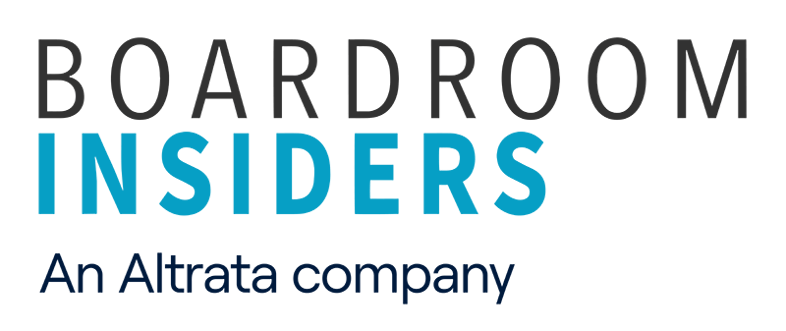Let's look at why C-Suite selling is so important. We've been talking about digital transformation for years but these efforts have largely been confined to the margins of the business or in silos of the business. Recently digital transformation efforts have shifted to the core of the business. Digital transformation and reinvention is critical to the survival of any business and therefore this effort has caught the attention of the CEO and the rest of the C-Suite and they are paying a lot of attention to technology purchases that are being made to support the effort.
Let’s take a look at a comment that was made on a recent earnings call. This is an analyst talking to the CEO of Adobe and he was basically saying, "Look, the decisions for a lot of your product suites are now being made at a higher level in the C-Suite. They've caught the attention of the CEO. So, what are you doing to change your sales process?"
These conversations in earnings calls at the CEO level show the importance of C-Suite selling. Here's another comment from an earnings call that took place last year. This is a SaaS company that made its business selling to small and medium businesses and they recently shifted to an enterprise selling focus. They were having a lot of success at closing bigger Enterprise deals--more than 600 of them in a single quarter.
They were also seeking great renewals with enterprise customers. And as it turns out they were doing these deals with the CEO and other members of the C-Suite. And they were being viewed by their customers as a critical partner in helping them make that transition to a digital native business. I don't know if any of you out there can guess what company this is, but it's Salesforce.
It was no surprise to me that Marc Benioff was on the forefront of CXO selling because he's been talking about it for a decade. I read his book 'Behind the Cloud' back in 2009, and he wrote about C-Suite selling and he laid out three tenets: people buy from people; relationships matter; and perhaps most importantly, the need to sell business outcomes, not products, when you are talking to the C-Suite.
The C-Suite doesn't care about your product features and benefits. All they want to know is, what you can do to help move their business forward? So, in that 2016 earnings call, Benioff talked about how CEOs have become the 'de-facto chief digital officers' responsible for driving transformation of the core of the business to being digital native.
So, if he's been talking about this for quite a while, you might wonder why it was only recently that he had success with C-Suite selling to the point where he can talk about it on earnings calls with analysts?
Well, in 2013 he hired a man named Keith Block from Oracle to drive this enterprise selling effort. Keith Block got the sales force in lock step with this vision and figured out a way to hold them accountable and measurable.
Now we're going to shift to talking about "Scale." You saw that Salesforce closed 600 enterprise deals in a single quarter. That's pretty good scale. Our customers often ask us, "If I roll out a C-Suite selling effort how can I possibly scale it?"
This next case study talks about the need to recalibrate your definition of scale. So, if you're rolling out C-Suite selling, you may not be able to be successful with thousands of accounts. You might be looking at a handful of accounts, like 50 accounts or 100 accounts. So that's the first thing to think about.
This is this is Dorothea Gosling. She works for a company called DXC Technology, which was recently created by the merger of CSC with HP Enterprise Services Business. Dorothea was working for CSC when about four years ago she created an account based marketing program, which was quite successful. But she realized with this merger coming up between CSC and HP Enterprise Services, that scaling large account ABM was going to be difficult because the company was going to be in flux for some time. So she pivoted to what she called a “two prong” approach; the first prong involved narrowing her ABM focus to just 200 named accounts. Plus she rolled out something new, which she calls “Pursuit Marketing,” and she reserved this program just for large strategic deals where there was a big opportunity on the table.
This is how she described pursuit marketing but, when I spoke with her, my impression of it was sales and marketing collaborating together to “swarm” the account with very targeted messaging, communications and touch points all designed with the end goal of closing a specific deal. The goal was to close these bigger deals faster with a small number of strategically important accounts and make sure that sales was totally bought in to the effort. She positions Pursuit Marketing as a privilege and not a right, and requires sales to fully engage and share information with the marketing team.
This has been a hugely successful program. Sales has fully bought into it. She was lucky in that she rolled out her first program around Metlife. They closed the Metlife deal and it was a landmark deal that was talked about on an earnings call by CSCs CEO. He said it was a landmark deal for three reasons; the first reason was the sheer size of the deal. It was one of the biggest deals they've closed in five years.
The second reason was it cemented CSCs leadership in the insurance industry vertical; they are very confident that now that they've closed this Metlife deal that more will follow in the [insurance] industry.
And, the third reason, and this is really important, is that the margins of the deal were very attractive. This deal was not the result of an RFP or a competitive “bake-off” that was won on price. It was the result of conversations in the C-Suite around how CSC could help Metlife drive a specific business outcome. Business outcome selling, not product selling. Dorothea's program was critical, because it swarmed the account at all levels--including the C-Suite--with very specific information and messaging.
Now let's talk about why C-Suite selling is so difficult. C-Suite selling is so difficult because the methods required are really the antithesis of where sales has been heading in the past 15 years.
Sales has become more automated. We’re sending more emails and making more phone calls using technology. What I recently heard from one c-level executive is that he ignores all of these automated emails. Secondly, he told me that he doesn't get any phone calls anymore and, when somebody does call him, they typically have not done their homework on who he is, what he's responsible for, and what his current initiatives are.
This is information that you can often get publicly, so there's no excuse not to have it. He says when someone does do their homework it's usually a good conversation, and he'll often agree to next steps, or to make a referral elsewhere within the organization. He also said he never gets mail anymore. When I was in sales twenty years ago, we used to send targeted packets to executives.
But the problem is everybody else was doing it, too. Now, no one is doing it. So, that's something to consider when you're C-Suite selling.
But no matter what you do, make sure that what you're providing, whether it's an email, a phone call, a voice mail communication, snail mail, make sure that you have a very strategic targeted message that shows that you've done your homework on the executive and their company, and that you have a hook--or a way of driving one of their initiatives forward. That's the way that you're most likely going to get some next steps.
Now let's talk about the five things you need to succeed if your organization is rolling out C-Suite selling.
The first thing you need is the support and engagement of your own executive team. We saw in the Salesforce example how Keith Block and Marc Benioff are so committed to meeting with customers and collaborating with customers to come up with the right solution for them. You need some C-Suite executives of your own in your corner to help you go out and have those meetings.
The second thing you need to succeed is sales training. Most sales teams in the technology vendor space have not successfully made the leap from point product selling to business outcome selling, and there are a lot of great training programs out there that can help your sales team develop that business acumen so that they can have those those business conversations at the executive level.
The third thing you need is research and insight on your customer. Often when customers come to us, the first thing they ask for is lists of executives and contact information and org charts. And, you need all of those things, but what you also need is to understand what they want to talk about when you reach them. Because if you don't have a good hook the first time you reach them, you may not get another chance.
So I would encourage you to pay attention to these second third bullets: What do they want to talk about and how do you connect the dots between that and what you're selling?
Number Four: Sales and Marketing. If you are a sales leader you can go to marketing and ask for these things. First, collaboration around big deals. You saw in the Dorothea Gosling case study how she had such an agile marketing organization in place that she could deploy teams to swarm an account where there was a big deal on the table. So that is something you could ask your marketing organization to develop.
Secondly, marketing is often the source of the research and insight about your customer, and they can spoon feed you this insight as needed. This is an example of something that Marketing is often providing as sales teams are going into key meetings, and this is just baseline. You should go deeper than this, but at minimum everyone going into your customer meeting should know these types of things.
Executive to executive relationship mapping is something that marketers are focused on more these days. Here's an example of that and this, as you can see, goes way beyond LinkedIn. This was used to plan for a CIO event. And what we found is that six of the people on their guest list had been CIOs at BofA at the same time in different divisions.
So there's a lot you can do with this type of powerful insight around a CIO event.
Two more things you can ask marketers for are thought leadership content, which most marketers are doing a good job with these days, and also, CXO engagement programs which create in-person touch points through which you can deliver that thought leadership content.
Here are a few examples of CXO engagement programs. Executive Sponsorship Programs: you can pair one of your executives with one of your strategic accounts so they can be the designated sponsor of it. But try to let insight from your customer drive that matchmaking. For example, if your customer CEO has a long history in the military, maybe you have an executive on your team that has that same kind of background, and that would make a nice match. Likewise, you can make these matches based on common passions such as aviation, or golf, or sailing.
Executive Briefing Center Programs: Maybe your company has a beautiful executive briefing center that showcases all of your products and customer successes and you'd like to bring your customers through. Often we see that more attention and investment is made in the catering than in who needs to be in the room and what you are going to talk about. That takes insight and doing your homework, and what we always recommend, is that you do that homework so you can plan better experiences for your customers and better conversations.
CXO Events: Marketers are investing millions in third-Party CXO events as well as proprietary CXO events. Often there is more investment made in the catering and the social events then in doing the research to figure out who you want in the room, how do you get them there, and what do they want to talk about. So that's something you should really consider with CXO events.
And the last thing you need to succeed with CXO selling is a focus on measurement and accountability. Is what you're doing working? And if so, how do you compensate and incent sales to exhibit the behavior that you want around C-Suite selling? What we encourage is not just measuring things like revenue growth in accounts where you are engaging the C-level, but also look at the stories around the successes you've had. How you've moved the needle. So if you, for example, have been inviting a certain CIO to your CIO event for five years and they've never shown up, maybe you changed your approach. You learn something about them and provide a hook to get them to your event. Maybe you finally succeeded in getting them in the room and you got them talking with your own executives, and they've agreed to some next steps. There's no deal or revenue to measure there yet, but there's a great story, and you need to tell that around your organization to prove the power of CXO targeting and engagement.
This is the end of our presentation. I hope this was helpful, and we look forward to sharing more great insight from Boardroom Insiders in the future. Thank you very much.








Share Your Thoughts